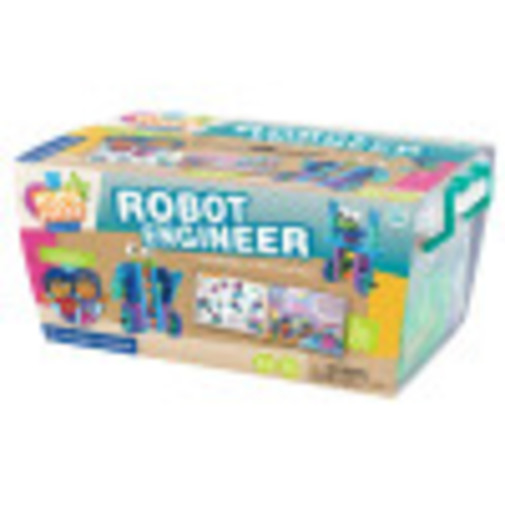We use cookies to make your experience better. To comply with the new e-Privacy directive, we need to ask for your consent to set the cookies. Learn more.
Robot Engineer (Kids First Level 1)
A 53-piece kit containing the entertaining story of two children taking a trip to a candy factory and building 10 assorted robots to help with various tasks. While reading, kids build various non-automated robots with moving parts as they come up in the story, including a robotic drone, robots that move around the factory, taffy-pulling robots, and more.
Read the funny story of two inquisitive kids, Ty and Karlie, and build simple, non-motorized models of the robots they construct and fix during their adventure to an automated candy factory. During this zany outing, Ty and Karlie build various robots to perform tasks and solve problems in the factory. The robots have moving parts, wheels, and gears, so kids can learn firsthand about simple machines and gear trains. As you follow the story, you can build models of the ten robots featured in the story. Large, colorful plastic building pieces make it easy for small hands to put the models together. In the story, the kids build robots with arms that rotate, turn, and spin. They fix a robotic arm and other specialized robots that complete specific tasks inside the factory. They construct a robotic drone that flies through the factory to coat the candies in sprinkles, wheeled robots that zoom across the factory floor, a taffy-pulling robot, and a funny gum-kneading robot. From each humorous segment of their silly adventure, the kids learn something new about robots and machines. This 53-piece science kit combined with the beautifully illustrated storybook provides an engaging way to teach simple engineering concepts to preschool-age kids. Start laying the groundwork for strong STEM related skills and comprehension. This kit helps develop fine motor skills, science and math skills, visual-spatial skills, and reasoning and concept development skills.
This great new series is for your youngest engineers and scientists. Level 1 is for ages 3 to 5, and level 2 is for 5 to 7. This is a brand new line for Thames and Kosmos and is intended to introduce young learners to science and math concepts while also developing fine motor skills and visual/spatial reasoning. At level 1, the building is accompanied by an engaging storybook (24 pages in length), pretend play, and simple activities. The activities reflect the content of the story line and use chunkier building pieces that are great for smaller hands. Each kit comes nicely packaged in a durable storage container.
Level 2 takes children to the next level of science there are no storybooks, but a detailed 48-page, illustrated guide book comes in every kit. These kits introduce children to the scientific method and teach science basics using hands-on experiments. Level 2 kits do not have a storage container.
| Product Format: | Other |
|---|---|
| Brand: | Thames and Kosmos |
| Grades: | PK-2 |
| EAN/UPC: | 814743017382 |
| Length in Inches: | 11.5 |
| Width in Inches: | 14.625 |
| Height in Inches: | 2.75 |
| Weight in Pounds: | 1.95 |

